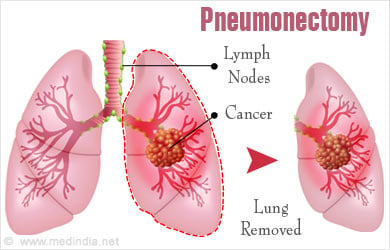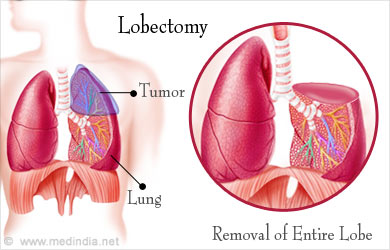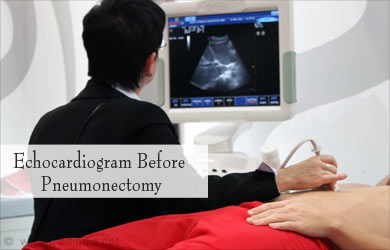What is Pneumonectomy?
Pneumonectomy is a surgical procedure in which the entire lung is removed. It is an open-chest technique, which is usually done for lung cancer cases that cannot be treated by removal of a small portion of the lung.
Each lung is divided into lobes, the right lung has three lobes, while the left lung has two (the third lobe of the left lung is converted into a structure called the lingula). Each lung can also be divided into ten bronchopulmonary segments. Each segment has its own bronchus and arterial branch.

Who Undergoes Pneumonectomy?Pneumonectomy may be used for patients with the following conditions:
- Lung cancer, when limited surgery may not yield desired results.
- Non-cancerous conditions like severe cases of chronic obstructive pulmonary disease (COPD), or severe trauma to the lungs which cannot be surgically repaired.
What are the Types of Pneumonectomy?
Types of pneumonectomy include the following:
Standard pneumonectomy: In this procedure the affected lung i.e., either the left or right lung is removed.
Extrapleural pneumonectomy: This type of surgery is most often done to treat mesothelioma, which is a kind of cancer that begins in the lining surrounding the lungs, called pleura. The surgical procedure involves removing the left or right lung along with portions of the diaphragm, pericardium (the membrane lining the heart) and the pleura.
Completion pneumonectomy: This type of surgery is done to remove a lung whose part was already removed surgically earlier.
What are the Other Types of Surgery for Lung Cancer?
In several cases of lung cancer, the entire lung does not require to be removed. A limited surgery may be carried out in such cases. Examples of such limited surgeries are:
Lobectomy: This is the most common type of surgery for lung cancer. It involves removal of a lobe of the affected lung (If two lobes are removed, the procedure is called bilobectomy). Your doctor will recommend this type of operation if he/she thinks that the cancer is limited just to the lobe of one lung.

Sleeve Resection: This procedure may be done for cancers located in the central area of the lung and spreading into a bronchus. In this procedure, the affected section of the bronchus and any surrounding cancer in the lobe is surgically removed.
Video-Assisted Thoracoscopic Surgery (VATS): This is a type of keyhole surgery to remove very early small cell lung cancers. The doctor makes a small cut in the chest region and inserts a flexible tube with a telescopic camera in order to examine the lungs. Few incisions are then made in the chest and the surgical tools are inserted through them to carry out the surgery.
Wedge Resection and Segmentectomy: Wedge resection removes a wedge-shaped area of the lung that includes part of one or more lobes, while a segmentectomy involves removal of a segment of the lung.
These surgeries are used when the cancer is detected early and has not spread to other regions.
What are the Tests Recommended before Pneumonectomy?
Tests recommended before pneumonectomy include:
- Routine blood and other tests done before any surgery to make sure that the patient is fit for surgery
- Use of imaging tests like x-ray, CT scan, MRI and PET scan to study the extent of the disease.
- Tests to evaluate cardiac function like echocardiogram

- Tests where a biopsy can be taken like bronchoscopy or thoracoscopy. In these tests, a tube with a video camera at the end is introduced either through the bronchi or the chest, respectively
- Tests to study the function of the lungs like spirometry and oxygen saturation of the blood
How to Prepare for Pneumonectomy?
- Smoking cessation is advised as soon as lung cancer diagnosis is made
- Blood-thinning medications such as warfarin that the patient may be taking should be discontinued after consulting the doctor to prevent bleeding.
- NSAIDs such as ibuprofen or aspirin should be discontinued a week to ten days prior to the surgery date, again to prevent bleeding.
- Patients should be fasting overnight before the surgery. Fluid, nutrition and medication are administered through a ‘drip’ during the surgery, where a small tube is placed into one of the veins and attached to a bag of fluid.
How is Pneumonectomy done?
- Pneumonectomy is done under general anesthesia.
- The surgeon makes a long incision or cuts on the chest on the same side as the diseased lung. At times, removal of the fifth rib is warranted to have a better view of the diseased area.
- The diseased lung is then deflated.
- The main blood vessels entering and leaving the lung namely, the pulmonary artery and vein, are clamped and divided. Part of the bronchus going from the trachea to the diseased lung is also clamped and divided.
- The diseased lung is then removed from the chest.
- The bronchus stump is closed with sutures.
- A temporary drainage tube is inserted into the pleural space to draw out air, fluid and blood.
- The chest incision is then closed with sutures.
What are the Potential Complications of Pneumonectomy?
Pneumonectomy complications are not uncommon since it a major medical procedure. The incidence of complications is reported to be as high as 20-60%. Your doctor will inform you about them before your surgery. Here are few potential complications experienced by the patient:
- Bleeding into the thorax.
- The need for a respirator for a prolonged period after surgery.
- Pulmonary edema or accumulation of fluid in the lungs: This is generally seen within 24-48 hours after surgery. It may occur due to excessive fluids given during or after the procedure.
- Pneumonia or lung infection: This is generally seen in 2-15% of patients. Pus may also accumulate between the pleural membranes, resulting in empyema.
- Bronchopleural fistula, or an abnormal communication between the bronchus and pleura: This is seen more commonly with right pneumonectomy.
- Cardiac herniation: Shifting of the heart through an opening created in the pericardium during the surgery occurs at the end of surgery or in the immediate postoperative period. The triggering event is a change in the patient’s position, coughing, removal of the breathing tube, or connection of a chest tube to negative pressure.
- Heart problems: such as a heart attack, or abnormal heart rhythms.

- Post-pneumonectomy syndrome: Although rare, this syndrome could occur due to shifting of organs in the chest into the vacant space from where the lung is removed.
- Deep vein thrombosis or blood clots in the legs due to immobility during and after the surgery; these clots could travel to the remaining lung which result in a medical condition known as pulmonary embolism.
- Kidney problems or kidney failure
- Persistent pain in your incision or where your rib was cut





